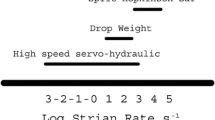Abstract
A new apparatus – “Dropkinson Bar” – has been successfully developed for material property characterization at intermediate strain rates. This Dropkinson bar combines a drop table and a Hopkinson bar. The drop table was used to generate a relatively long and stable low-speed impact to the specimen, whereas the Hopkinson bar principle was applied to measure the load history with accounting for inertia effect in the system. Pulse shaping technique was also applied to the Dropkinson bar to facilitate uniform stress and strain as well as constant strain rate in the specimen. The Dropkinson bar was then used to characterize 304L stainless steel and 6061-T6 aluminum at a strain rate of ∼600 s−1. The experimental data obtained from the Dropkinson bar tests were compared with the data obtained from conventional Kolsky tensile bar tests of the same material at similar strain rates. Both sets of experimental results were consistent, showing the newly developed Dropkinson bar apparatus is reliable and repeatable.
Access provided by Autonomous University of Puebla. Download conference paper PDF
Similar content being viewed by others
Keywords
12.1 Introduction
The material response at intermediate strain rates is of great interest to automotive industries and electronic packaging [1, 2]. However, the development of intermediate-strain-rate experimental techniques has significantly lagged behind the desire of material properties at intermediate strain rates. Current intermediate-strain-rate testing techniques are mainly based on servohydraulic system/drop table or Hopkinson bar methods. Either servohydraulic system or drop table for intermediate-strain-rate testing is an open loop system with inertia, or wave propagation, neglected. In addition to system inertia, specimen inertia has not been well discussed or properly addressed in current servohydraulic test frames or drop-table-based tests. Hopkinson-bar based apparatus accounts for inertia (or wave propagation) effect in both test apparatus and specimen. However, the gas-gun driven Hopkinson bars generate a relatively short duration of loading, which is insufficient to deform the specimen to relatively large deformation at intermediate strain rates, although long Hopkinson bar systems have been recently developed [3,4,5]. A hybrid concept that combines a servohydraulic test frame (or a drop table) and a Hopkinson bar has also been proposed for intermediate strain rate testing [6, 7].
In this research, we developed a similar hybrid apparatus – Dropkinson bar – which combines a drop table and a Hopkinson bar. The new Dropkinson bar is capable of (1) generating a stable intermediate impact speed with a long duration (1–2 ms or even longer); (2) curtailing system inertia effect (no ringing in force history); (3) minimizing specimen inertia effect (uniform stress and strain in the specimen); and (4) facilitating constant strain-rate deformation in specimen (pulse shaping technique). The Dropkinson bar was utilized to characterize 304L stainless steel and 6061-T6 aluminum for verification.
12.2 The Dropkinson Bar Design
The Dropkinson bar was developed in tension mode as shown in Fig. 12.1. Upon the free drop of the carriage, the impactor attached to the bottom of the carriage impacts the impact plate at its center. The impact plate then transfers the impact load to the tensile specimen attached to the edge through an adapter. Such an impact load subjects the specimen to dynamic tension. The tensile stress wave then transmits into the vertical Hopkinson bar through the threads between the specimen and the bar end. The strain gages on the surface of the Hopkinson bar record the full load/stress history applied to the specimen. A custom-made laser extensometer, which followed the same concept as presented in Ref. [8], was implemented to the Dropkinson bar for specimen deformation measurement. The tensile stress-strain response is thus obtained.
12.3 Experimental Verification
A conventional Kolsky tension bar and the Dropkinson bar were used to characterize the same materials (304L stainless steel and 6061-T6 aluminum) with identical specimen geometry at the similar strain rates (∼600 s−1) for verification of the new Dropkinson bar apparatus. Five experiments were repeated with each apparatus and the average curve from the five experiments was used to represent the tensile stress-strain curve of the material. Figure 12.2 compares the averaged stress-strain curves of 304L stainless steel (Fig. 12.2a) and 6061-T6 (Fig. 12.2b) obtained from the Dropkinson bar and conventional Kolsky tension bar experiments. The flow stress obtained from the Dropkinson bar tests is approximately 3% higher than that obtained from the conventional Kolsky tension bar tests. However, when accounting for standard deviation during plastic deformation, the stress-strain responses obtained from the Dropkinson bar tests are consistent with those obtained from the conventional Kolsky tension bar tests for both materials. Therefore, the newly developed Dropkinson bar demonstrates the capability for mechanical characterization of materials at intermediate strain rates with high reliability and repeatability.
12.4 Conclusions
A new apparatus – “Dropkinson Bar” – has been developed for material property characterization at intermediate strain rates. This Dropkinson bar combines a drop table and a Hopkinson bar to generate a relatively long and stable low-speed impact to the specimen and to measure the load history. Pulse shaping technique was applied to the Dropkinson bar to facilitate uniform stress and strain as well as constant strain rate in the specimen. The Dropkinson bar was successfully verified through comparing the tensile stress-strain data for 304L stainless steel and 6061-T6 aluminum to those obtained from conventional Kolsky tensile bar tests at similar strain rates.
References
Lim, S.J., Huh, H.: Fracture loci of DP980 steel sheet for auto-body at intermediate strain rates. Int. J. Automot. Technol. 18, 719–727 (2017)
Jing, J., Gao, F., Johnson, J., Liang, F.Z., Williams, R.L., Qu, J.: Brittle versus ductile failure of a lead-free single solder joint specimen under intermediate strain rate. IEEE Trans. Compon. Packag. Manuf. Technol. 1, 1456–1464 (2011)
Gilat, A., Matrka, T.A.: A new compression intermediate strain rate testing apparatus. EPJ Web Conf. 6, 39002 (2010)
Luo, H., Cooper, W.L., Lu, H.: Effects of particle size and moisture on the compressive behavior of dense Eglin sand under confinement at high strain rates. Int. J. Impact Eng. 65, 40–55 (2014)
Song, B., Syn, C.J., Grupido, C.L., Chen, W., Lu, W.-Y.: A long split Hopkinson pressure (LSHPB) for intermediate-rate characterization of soft materials. Exp. Mech. 48, 809–815 (2008)
LeBlanc, M.M., Lassila, D.H.: A hybrid technique for compression testing at intermediate strain rates. Exp. Mech. 20, 21–24 (1996)
Petiteau, J.-C., Othman, R., Guégan, P., Le Sourne, H., Verron, E.: A drop-bar setup for the compressive testing of rubber-like materials in the intermediate strain rate range. Strain. 50, 552–562 (2014)
Nie, X., Song, B., Loeffler, C.M.: A novel splitting-beam laser extensometer technique for Kolsky tension bar experiment. J. Dyn. Behav. Mater. 1, 70–74 (2015)
Acknowledgement
Sandia National Laboratories is a multimission laboratory managed and operated by National Technology and Engineering Solutions of Sandia, LLC, a wholly owned subsidiary of Honeywell International, Inc., for the U.S. Department of Energy’s National Nuclear Security Administration under contract DE-NA0003525. The views expressed in this article do not necessarily represent the views of the U.S. Department of Energy or the United States Government.
Author information
Authors and Affiliations
Corresponding author
Editor information
Editors and Affiliations
Rights and permissions
Copyright information
© 2019 The Society for Experimental Mechanics, Inc.
About this paper
Cite this paper
Song, B. et al. (2019). Development of “Dropkinson” Bar for Intermediate Strain-Rate Testing. In: Kimberley, J., Lamberson, L., Mates, S. (eds) Dynamic Behavior of Materials, Volume 1. Conference Proceedings of the Society for Experimental Mechanics Series. Springer, Cham. https://doi.org/10.1007/978-3-319-95089-1_12
Download citation
DOI: https://doi.org/10.1007/978-3-319-95089-1_12
Published:
Publisher Name: Springer, Cham
Print ISBN: 978-3-319-95088-4
Online ISBN: 978-3-319-95089-1
eBook Packages: EngineeringEngineering (R0)






